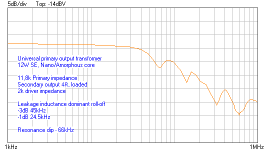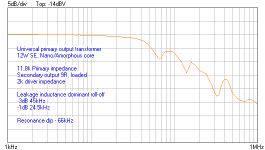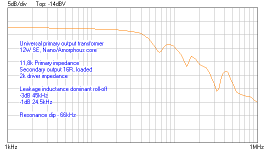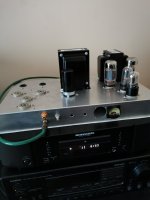There are so many OPTs to select from and as I understand, if I get it slightly wrong, the feedback loop will oscillate and do severe damage. I was also told one can't select a transformer solely based on the value of zed, though not what other parameters to use. So, I handed up a few transformers to select from:
"U082 PP output for EL84 UL
8000 ohms Rla-a. 40 W at 20 Hz. 200 mA per side. Also suitable for KT66, 6CA7 etc. Very high bandwidth. Only available in single 6 or single 8 ohms. 10 Hz to 80 kHz. Size P"
"U064 PP output for EL84 UL
8000 ohms Rla-a. 10W at 30 Hz. 80 mA per side. Choice of 43% or 20% UL taps. 25 Hz to 30 kHz. Size F" (Orange text I am concerned about, notice the schematic doesn't specify.)
I think based on a PDF I was provided this is the original: https://www.hificollective.co.uk/catalog/TX-OP-200-1-IE-PP-F.html though has not been confirmed.
"Audio Note push-pull output transformer (as featured in the Old Audio Note Oto amplifier)
Suggested valves - EL84/ECL86/6V6
Max Cl. A Power: 15 w
Primary / Secondary Impedances: 8K / 4 and 8 Ohms
Primary / Secondary wire: copper / copper
Core material - IE"
Huggygood used a Z=6.000kΩ with the specified values being Z=8.000kΩ (vintage OPTs).
Not sure how to copy specifications for these two:
https://www.lundahltransformers.com/wp-content/uploads/datasheets/1620_3_7_9202.pdf
https://www.lundahltransformers.com/wp-content/uploads/datasheets/1691.pdf

Thanks in advance. 🙂
Of to read more of Jones's Building Valve Amplifiers.
"U082 PP output for EL84 UL
8000 ohms Rla-a. 40 W at 20 Hz. 200 mA per side. Also suitable for KT66, 6CA7 etc. Very high bandwidth. Only available in single 6 or single 8 ohms. 10 Hz to 80 kHz. Size P"
"U064 PP output for EL84 UL
8000 ohms Rla-a. 10W at 30 Hz. 80 mA per side. Choice of 43% or 20% UL taps. 25 Hz to 30 kHz. Size F" (Orange text I am concerned about, notice the schematic doesn't specify.)
I think based on a PDF I was provided this is the original: https://www.hificollective.co.uk/catalog/TX-OP-200-1-IE-PP-F.html though has not been confirmed.
"Audio Note push-pull output transformer (as featured in the Old Audio Note Oto amplifier)
Suggested valves - EL84/ECL86/6V6
Max Cl. A Power: 15 w
Primary / Secondary Impedances: 8K / 4 and 8 Ohms
Primary / Secondary wire: copper / copper
Core material - IE"
Huggygood used a Z=6.000kΩ with the specified values being Z=8.000kΩ (vintage OPTs).
Not sure how to copy specifications for these two:
https://www.lundahltransformers.com/wp-content/uploads/datasheets/1620_3_7_9202.pdf
https://www.lundahltransformers.com/wp-content/uploads/datasheets/1691.pdf
Thanks in advance. 🙂
Of to read more of Jones's Building Valve Amplifiers.
There was concern that this is on a same topic, it is in fact a new topic. Thank you for your understanding and look forward to a resolution.
For EL84 you want at least 4K per tube so 8k p to p. The secondary is whatever load your speakers will be, 4 or 8 ohm. For EL84 you want a transformer that can handle at least 80ma of current. A little more is better but a lot more won’t help any. Get the widest frequency response you can afford. The output transformer makes or breaks the sound and stability of the amp. It is the one place not to save money!
For EL84 you want at least 4K per tube so 8k p to p.
Thank you for this information and making it so clear, appreciated. 🙂
Curious what you make of this, then:
"U065 PP Output for 2 pairs EL84 UL
4000 ohms Rla-a. 30 W at 20 Hz.
100 mA per side.
For 2 pairs parallel connected EL84.
43% UL taps. 20 Hz to 30 kHz.
Suitable for Vox AC30. Size M"
In other words, curious what happens when use a value less than 8kΩ?
The secondary is whatever load your speakers will be, 4 or 8 ohm.
Thank you for making sure understood this. 🙂
For EL84 you want a transformer that can handle at least 80ma of current.
Okay. All of them satisfy this, except the Audio Note which isn't specified.
Get the widest frequency response you can afford.
Good to know.
The output transformer makes or breaks the sound and stability of the amp. It is the one place not to save money!
Exactly, why I searched the forum for recommended brands and why no Hammond in the list. 😉
If you are paralleling output tubes you will need twice the current of one tube. In order to do that the output transformer must show half the impedance compared to a single tube. So, if 8k anode to anode is one tube then 4K is good for parallel tubes. When I say one tube I mean per side of the push pull. Now that you need twice the current as before the transforder must be able to carry that much current. In practice, for a pair of EL84s 100 to 120ma will be enough. My quote of 80ma was being very generous. The more current capacity of the opt usually the better built. The weight of it also is an indicator of capability, heavier is better. The higher the inductance the better the bass response. Higher inductance requires more wire and more laminations in the core. These are useful generalities. Most importantly, have fun and don’t over stress the details as it sucks the joy out of things!
If you are paralleling output tubes you will need twice the current of one tube. In order to do that the output transformer must show half the impedance compared to a single tube. So, if 8k anode to anode is one tube then 4K is good for parallel tubes. When I say one tube I mean per side of the push pull. Now that you need twice the current as before the transforder must be able to carry that much current. In practice, for a pair of EL84s 100 to 120ma will be enough. My quote of 80ma was being very generous. The more current capacity of the opt usually the better built. The weight of it also is an indicator of capability, heavier is better. The higher the inductance the better the bass response. Higher inductance requires more wire and more laminations in the core. These are useful generalities.
Duh, Ohm's Law. 🙄 Wow, I am looking forward to my brain being at full capacity.
Most importantly, have fun and don’t over stress the details as it sucks the joy out of things!
The fun went out days ago, one simple question has led to eight pages trying to pry out a simple answer. I was told the brand and model of OPT must be known otherwise the value of C8 and R16 in the feedback loop must be checked (there is a disagreement between the members on the method adding to confusion). Well, when I provided the brand and model of OPT, then the answer changed to the amplifier still not buildable (might function as an oscillator) yet no explanation of why.
As a very logical minded person that sees it black or white, I am puzzled so many have built this Audio Note L1 clone, even one with a vintage 6kΩ OPT, and they sound great and not melted their speaker cables (was told this happen if the values were not adjusted for each brand of speaker cable).
Though because I am stubborn and/or tenacious (decide for yourself which it is 😛 ) and it is the only option for a monoblock EL84 PP (the recommended Dynaco ST-35 reproduction OPTs NLA), not quitting. I am tired of damaging speakers with a wonderfully sounding 75 watt transformer (I never payed attention to wattage and all three speakers were free) and now that have the financial opportunity (small SSI back payment must be fully spent in nine months) time to grow up and upgrade to separate pre amplifier and amplifier (versus an integrated). Eventually will build a BIB with full base for enjoying my organ music LPs and lesser intent my 1960s and 1970s rock and roll. One bite at a time. 😉
And forgetting my manners. I appreciate the explanation additional tubes require more current to drive them, thank you! 🙂
Don't worry about stability, the OPT isn't a cause of this so much, it's the amp design and gain that leads to instability for the most part. A couple of EL84's in PP won't cause too many problems though unless you give it loads of FB..
To find R16/C8 is a doddle. Build the amp, get a 20k pot, a 10 turn type is better for this but use what you have, connect it up in the FB loop, power the amp up whilst monitoring the OP on a scope. Turn down the resistance till THD reduces and the frequency response gets better till you find the right spot. You want to set it so THD etc is improved, but not too much that you get instability or too low an output.
To find the C, replace the pot with the nearest fixed resistor, feed in a 10khz square wave, monitor on a scope, try different C's till you get a good clean SQ wave. You can spend a lot of time doing this, but you could just use your ears and do it in five minutes.
Andy.
To find R16/C8 is a doddle. Build the amp, get a 20k pot, a 10 turn type is better for this but use what you have, connect it up in the FB loop, power the amp up whilst monitoring the OP on a scope. Turn down the resistance till THD reduces and the frequency response gets better till you find the right spot. You want to set it so THD etc is improved, but not too much that you get instability or too low an output.
To find the C, replace the pot with the nearest fixed resistor, feed in a 10khz square wave, monitor on a scope, try different C's till you get a good clean SQ wave. You can spend a lot of time doing this, but you could just use your ears and do it in five minutes.
Andy.
For EL84 you want at least 4K per tube so 8k p to p. The secondary is whatever load your speakers will be, 4 or 8 ohm. For EL84 you want a transformer that can handle at least 80ma of current. A little more is better but a lot more won’t help any. Get the widest frequency response you can afford. The output transformer makes or breaks the sound and stability of the amp. It is the one place not to save money!
For a P-P OPT, there is no to little magnetizing Idc due to direct currents canceling each other inherently in the PP topology. So current capacity doesn't really matter. Primary voltage swing only does, which determines most of the flux density. Current capacity can be applied only to idle power dissipation, which is pracically not really a problem in OPTs. For example, 2W of Pdiss at 80mA DC applies to 312.5 Rdc at the primary, which for 8k means 3.9% primary loss.
Hi
please try to read this
https://www.diyaudio.com/community/threads/el84pp-a-simply-circuit.377499/
In my opinion use always a single secondary and a schematic where the test lab are published.
In this way you have a good feeling about the final results
Walter
please try to read this
https://www.diyaudio.com/community/threads/el84pp-a-simply-circuit.377499/
In my opinion use always a single secondary and a schematic where the test lab are published.
In this way you have a good feeling about the final results
Walter
There is no problem developping an OPT with similar behavior in the frequency response of all possible secondary options. I have direct proof by some recent work of mine, you can see a comparison of frequency response attached of a "universal" type of OPT, with 4k-8.2k-6.6k-11.8k primary options and 4R-9R-16R secondary options.
All you need to do is respect some rules of capacitance distribution between the primary and secondary layers. In this project I use secondary interleaving packages of 3 layers, where the mid layer represents 1R and it is sandwiched by the outer 4R unipotential layers in parallel. They employ the role of capacitance shield and guarantee a similar frequency response behaviour of all secondary connections.
I intend to write a long topic on this some day for fellow audio diyers and transformer designers, but still can't put all my work notes into systematic and understandable order.
All you need to do is respect some rules of capacitance distribution between the primary and secondary layers. In this project I use secondary interleaving packages of 3 layers, where the mid layer represents 1R and it is sandwiched by the outer 4R unipotential layers in parallel. They employ the role of capacitance shield and guarantee a similar frequency response behaviour of all secondary connections.
I intend to write a long topic on this some day for fellow audio diyers and transformer designers, but still can't put all my work notes into systematic and understandable order.
Attachments
Let me try to suggest a couple of options, taking into account that you are in the USA:
Hammond 1650FA: https://www.digikey.com/en/products/detail/hammond-manufacturing/1650FA/2358103
Edcor CXPP25-8K: https://edcorusa.com/collections/tu...25w-8k-ohms-push-pull-tube-output-transformer
The Edcor is probably a better value.
Hammond 1650FA: https://www.digikey.com/en/products/detail/hammond-manufacturing/1650FA/2358103
Edcor CXPP25-8K: https://edcorusa.com/collections/tu...25w-8k-ohms-push-pull-tube-output-transformer
The Edcor is probably a better value.
Andy (@Diabolical Artificer ), I appreciate interjecting clarity, thank you.
Does this need to be done if the schematic and specifications are exactly followed?
Does this need to be done if the schematic and specifications are exactly followed?
Let me try to suggest a couple of options, taking into account that you are in the USA:
Hammond 1650FA: https://www.digikey.com/en/products/detail/hammond-manufacturing/1650FA/2358103
Edcor CXPP25-8K: https://edcorusa.com/collections/tu...25w-8k-ohms-push-pull-tube-output-transformer
The Edcor is probably a better value.
I appreciate the recommendation, thank you! 😀
Notice it is a 23 percent, searched there website, see a couple PPs there, got looking, and darn it, this one looks simpler than the one I posted, does it not?
http://diyaudioprojects.com/Tubes/EL84-Mini-Block-Amps/
Also has some of the brands specified, too.
What about the larger distortion figures?
I would not use that schematic. The output tubes are also used as phase inverters, it is not very efficient to say the least.
Either your original schematic or Tubelab's SPP (simple push pull) would be my (and many others here) recommendation. Plenty of support here, especially for SPP.
Either your original schematic or Tubelab's SPP (simple push pull) would be my (and many others here) recommendation. Plenty of support here, especially for SPP.
I would not use that schematic. The output tubes are also used as phase inverters, it is not very efficient to say the least.
Either your original schematic or Tubelab's SPP (simple push pull) would be my (and many others here) recommendation. Plenty of support here, especially for SPP.
I appreciate this feedback, thank you! 😀
The hangup I have with the SPP is it is stereo. I set myself on monoblocks because of simplicity and able to check and learn from one channel, then move to the next channel. If this is an unreasonable or poor plan, I am willing to abandon and go with the SPP.
+1 for Tubelab SPP. Simple indeed and well tried and loved. I think doing two monoblocks will certainly cost more and not necessarily be a better learning experience.
Otherwise, if you could get the desirable Dynaco Z-565 output transformers build a Dynaco ST35 clone. (Dynakit has reportedly been shipping some to people who ordered them, in spite of their website showing out of stock)
https://www.dynakitparts.com/shop/st-35-transformer-set/
Otherwise, if you could get the desirable Dynaco Z-565 output transformers build a Dynaco ST35 clone. (Dynakit has reportedly been shipping some to people who ordered them, in spite of their website showing out of stock)
https://www.dynakitparts.com/shop/st-35-transformer-set/
About monoblocks, It's of course your call, but I personally would not go that way for a relatively small amplifier.
You can always build half of a stereo amp, and build the second channel when everything works on the first one, that's exactly what I did in my build:
You can always build half of a stereo amp, and build the second channel when everything works on the first one, that's exactly what I did in my build:
Attachments
About monoblocks, It's of course your call, but I personally would not go that way for a relatively small amplifier.
Mind me asking why?
Giving your suggestion serious thought, for your information.
In my experience monoblocks are double the complexity, almost double the size with commonly available chassis, and more expensive when you factor in the fact that you actually save money in most instances buying one power transformer rather than two- the cost difference is not huge but it is there.
No real downsides other than complexity and the amount of work involved.
No real downsides other than complexity and the amount of work involved.
- Home
- Amplifiers
- Tubes / Valves
- Selecting an OPT



